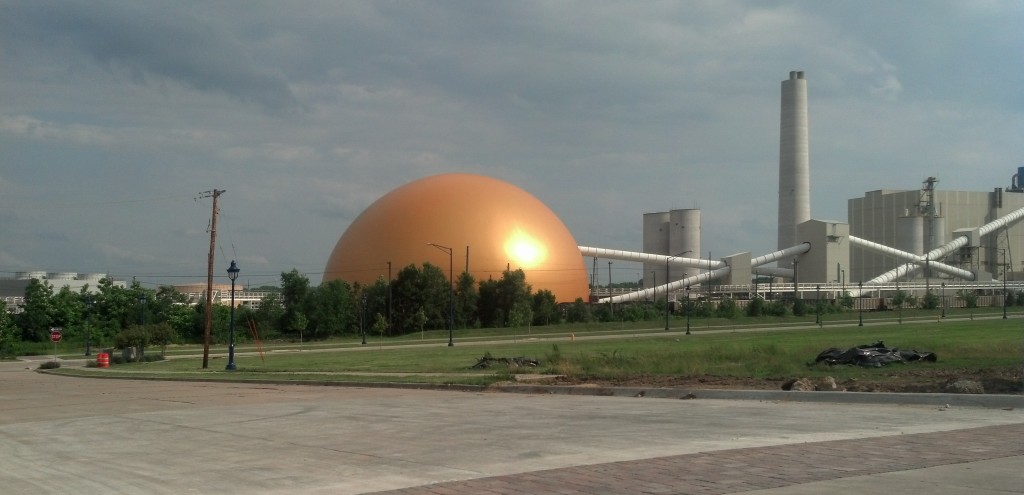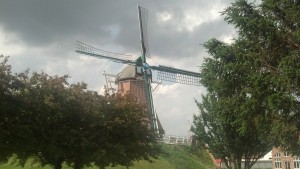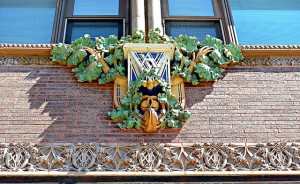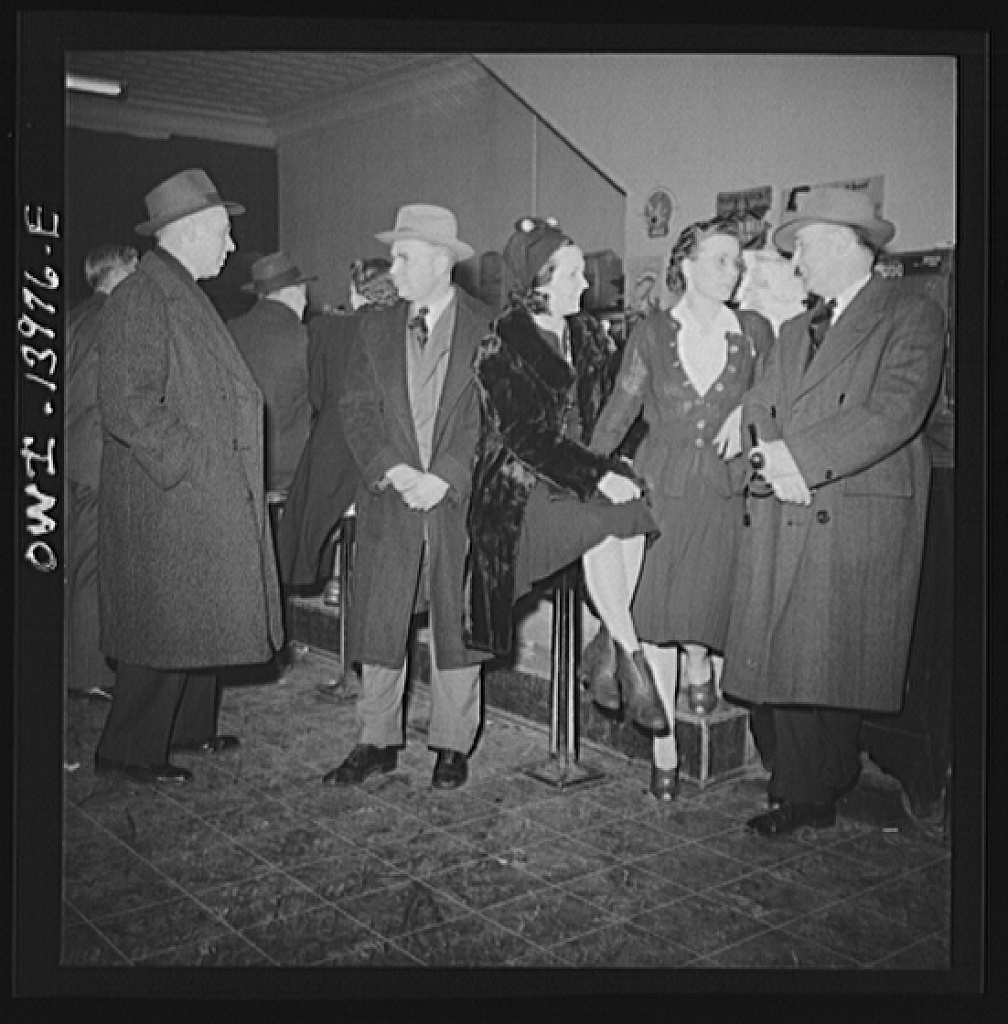
This Archer Daniels Midland coal storage facility in Clinton, Iowa, is hard to miss. (Photo by Michael E. Grass)
CLINTON, Iowa — There are two ways to cross the Mississippi River heading west on the Lincoln Highway from Illinois into Iowa. U.S. 30’s Gateway Bridge, a suspension span, provides a faster way through the area. But it skips Fulton, Ill., the town where the Lincoln Highway previously crossed on a bridge dating to 1891, later torn down and replaced.

The Windmill Cultural Center in Fulton, Ill., sits adjacent to the town’s Mississippi River levee. (Photo by Michael E. Grass)
Today, there’s a giant Dutch-style windmill that sits atop Fulton’s Mississippi River levee at the foot of 10th Avenue at 1st Street, where a the Windmill Cultural Center is located. Dutch settlers originally came to this spot along the Mississippi in 1835. Many more, including members of the Dutch Reformed Church, started coming in higher numbers in the 1870s. (The city hosted its Dutch Days in May.)
Today, you can take the 1970s era Mark N. Norris Bridge to connect with U.S. 67 to head into the heart of Clinton, formerly the “Lumber Capital of the World,” and link back up with U.S. 30 to head west. (My hometown, Grand Rapids, Mich., is the “Furniture Capital of the America.”) Clinton’s Sawmill Museum is on Grant Street, along Clinton’s Mississippi River levee.
Sawmills in Clinton processed lumber that came downriver from Minnesota and Wisconsin along the Mississippi. That processed lumber was then taken by rail to Chicago and points east, or to points farther downriver. But Clinton’s lumber boom went bust in the 1890s.
When the 1919 Transcontinental Motor Convoy came entered Iowa at Clinton, it found the Hawkeye State’s easternmost city on uneasy economic ground.
As Pete Davies wrote in “American Road“:
When the convoy came through twenty years later, the town hadn’t really recovered. The population was still shrinking, now below twenty-five thousand. In this context, being on the Lincoln Highway meant worlds to people. It was the artery that would bring them new business, and it meant so much to them that they’d even called their baseball team after it; Clinton was represented by the Lincoln Highway Athletic Club.
***

Louis Sullivan designed the Van Allen’s department store building in Clinton, Iowa. (Photo by chicagogeek via CC BY-ND 2.0 »)
In 1913, the same year when the Lincoln Highway was routed through Clinton, plans were announced for Van Allen’s new department store building downtown at Fifth Avenue S. and S. Second Street. It was designed by the great Chicago architect Louis Sullivan, who had mentored Frank Lloyd Wright more than twenty years earlier.
To appreciate any Sullivan building, careful study of the intricate exterior detailing is necessary. In this case, the dominant elements include mullians which, according to Joseph Siry in the Journal of the Society of Architectural Historians, “may suggest the relation between mercantile interests and regional agriculture which preoccupied the Van Allens as progressive businessmen who saw Sullivan’s building as part of a larger vision for their city’s development.”
***
Clinton was connected by rail to Chicago via a river crossing that originally opened in 1865 and was subsequently replaced and expanded over the years. Because of that Mississippi River crossing, it’s remained a railroad town.
Poking around the Library of Congress’ Prints and Photographs Collection for photos from Clinton, I came across a set taken in 1943 by the great Jack Delano for the U.S. Farm Security Administration. It gives just a peak of his long career “photographing everything from coal miners, sharecroppers, railroad men and Puerto Rican canecutters,” according to The New York Times Lens blog.
The set documents the everyday lives of Chicago and North Western Railroad workers includes a variety of shots from Clinton. My favorite caption involves a photo captured at a local bowling alley:

(Photo by Jack Delano/U.S. Farm Security Administration via Library of Congress >>)
Clinton, Iowa. Rear brakeman Clarence Averill (right) goes over to the bowling alley in the evening with friends. Left to right: Lester Stein, a passenger brakeman on a streamliner; Jim Cross, a freight brakeman; and Miss Lucille Disher, who runs the boarding house where they all stay when in Clinton. The other woman is the proprietress of the bowling alley. That night was ladies night, so there was no bowling for the men. Instead, they had beer and talked.
***
Just as with entering Clinton on the Lincoln Highway from Illinois, there are two options for leaving Clinton on the way west to Cedar Rapids. The original route 1913 route leaves town via 4th Avenue N, Springdale Drive and 13th Avenue N. (Iowa has very clear and detailed signs for the Lincoln Highway.)

The gigantic ADM complex in Clinton, Iowa (Photo by Loco Steve via CC BY 2.0 >>)
The more modern way is via U.S. 30 to the south of downtown, which parallels the Union Pacific railyards and a gigantic Archers Daniel Midland complex, including its Clinton Cogeneration Plant and one of the largest corn wet mills anywhere in the world, according to Power magazine.
While the entire ADM complex in Clinton might be considered a modern industrial landmark, there’s one prominent feature that has become a new symbol for Clinton: the big gold dome.
The reinforced concrete structure, which helps conceal a coal storage facility, is easily visibile from U.S. 30 because of the gold fabric layer that protects it. “When it’s sunny, it will just blind you,” local resident Eric Kline told the Quad City Times in 2007.
Just as the dome went up at that time, a familiar Clinton landmark, a grain silo with a Mr. Peanut mural on it, came down.
St. Louis may have its big arch but Clinton has its own landmark that’s just as impressive.

Pingback: One Night in Cedar Rapids | The Lincoln Highway Guide